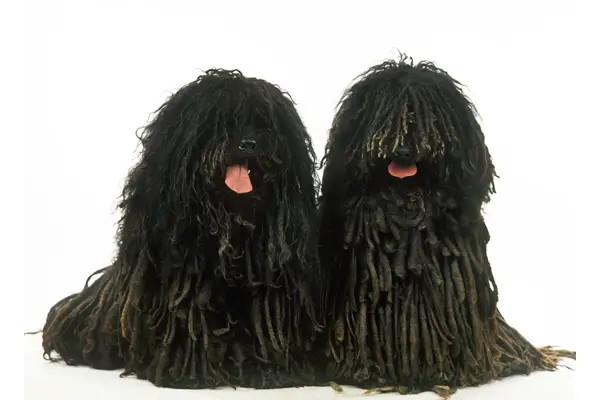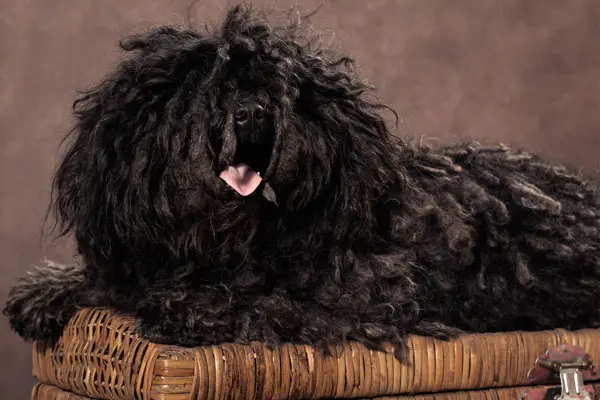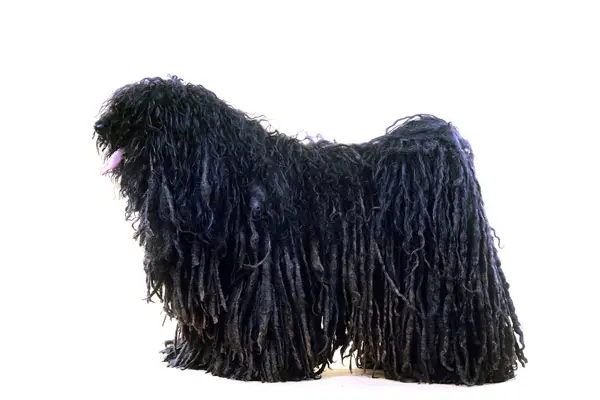Pulik (pulik is used for a group of Puli) dogs are medium-sized dogs known for their mop-like appearance. Their tails are tightly curled at the back of their corded coats. These dogs’ coats are never silky and clump together very easily, allowing them to form that dreadlock appearance. These coats can reach the ground if you’d want, and they only come in solid colors.
Pulik are not dogs for beginners, especially when it comes to their coats’ maintenance. There are some owners, though, that decide to trim off the coat for easy grooming. However, if you plan to show off this dog for dog shows, corded coats are the only ones accepted in many countries while the US accepts brushed coats.
These dogs are excellent family companion dogs. They are very energetic, playful, and lively – they would be a perfect fit for regularly active owners.

Puli Statistics
| Dog Breed Group | Herding |
| Breed Size | Medium |
| Height | 17 inches (male); 16 inches (female) |
| Weight | 25-35 pounds |
| Lifespan | 10-15 years |
Puli Ratings
| Energy level | |
| Exercise needs | |
| Requires attention | |
| Playfulness | |
| Trainability | |
| Shedding | |
| Grooming | |
| Friendly with family | |
| Friendly with kids | |
| Friendly with strangers | |
| Friendly with other dogs | |
| Prey Drive |
Puli History
The Puli is a Hungarian dog with an ancient history. They are believed to have Asian origins and descended from Tibetan Terriers. According to the theory, around 900 AD, the Tibetan terrier was brought to Hungary by nomadic tribes.
Pulik immediately became prized for their herding abilities. They were also mostly preferred by shepherds as they were easy to see with their dark coat colors.
These dogs are believed to have been herding sheep for thousands of years. This is evidenced by a grave found in Iraq of a man and a dog that resembles the modern Puli. Historians have also found Clay plaques of Sumerian laws about animals and have lines that refer to the Puli.
Around the 1800s, the dogs were bred more specifically by only retaining their very best qualities. However, as the breed standard was written, the breed almost came close to extinction as the need for them decreased.
By World War II, their numbers suffered more. Due to their popularity, they were sent to other countries. Four of these dogs were sent to the US and became the foundation of the US’s breed.
Fortunately, after everything the dogs went through, their number started to grow back in Hungary. By 1959, the Hungarian Puli Club was formed, and slowly the Pulik numbers came up to how they once were.
In the US, Puik was finally recognized by the American Kennel Club in 1936, but it wasn’t until 1951 that the Puli Club of America was formed. Now, the breed ranks 160th as the most popular dog breed in the US.

Puli Temperament
Pulik are loyal, smart, and home-loving dogs. They are very playful and lively that some even refer to them as bouncy. They were originally herding breeds, so they are natural athletes.
These dogs are very dedicated and loving to their family. They make excellent companions due to their strong background in accompanying shepherds before. But other than being great companions, they are also guardians.
The Puli is not that friendly with those outside his family. With their impressive eyesight and hearing, they are alert and suspicious, making them excellent watchdogs for your home.
When it comes to animals, their temperament can range from playful to bossy. They can also be very territorial with strange animals, and their strong prey drive would make them want to chase smaller animals.
It’s essential to give them early socialization so they can manage their behavior towards other people. This will help them become more well-rounded and calm dogs. Get them accustomed to new people and new animals, so they don’t come to attack someone.
They are one of the smartest dog breeds out there, so they’re really not for inexperienced owners. You need to be strong, firm, and consistent to be able to lead them. However, be careful not to handle them harshly as they can be very sensitive.
Puli Care Requirements
- Nutrition: Puli dogs should do well on any diet, as long as meals are high-quality and complete with all the essential nutrients. Like any other dog breeds, it’s vital to watch the number of calories you feed your dog every day. You don’t want them to get overweight, or they’ll become more prone to health diseases. If you’re feeding your dog home-cooked meals, it’s crucial that you only buy high-quality ingredients. You can get proteins from animal meat, fats from fish oils or chicken oils, and carbohydrates from whole grains or potatoes. It’s also nice to add fruits and vegetables to their diet for better digestion. If you want to serve dog food and dog treats, choose the premium quality ones too. Make sure to check the label and stay away from those containing fillers, additives, and by-products with very low nutritional value. It’s always a great idea to visit your vet and note if your dog has any allergies and make sure to stay away from those ingredients. You can also ask for specific feeding requirements that align your dog’s age, activity level, metabolism, etc.
- Grooming: Pulik are best known for their corded coats. It’s up to you how you want to maintain their coats: corded, brushed, or clipped. In terms of grooming, you can keep them neat and beautiful with regular bathing. It takes special expertise to keep their coats corded without it forming into mats. Take them into a professional groomer once or twice a year to have their coats corded again, so it remains neat. As for the ears, you need to clean it out regularly, once a week if you must. And the nails must also be trimmed regularly so they won’t feel any pain and discomfort.
- Exercise: Pulik are highly energetic breeds that need to be exercised physically and mentally, so they stay healthy. Mental stimulation is most important, and you should keep physical activities to a minimum when they’re still puppies. You can even have them participate in canine sports, which include herding, obedience, and agility.
- Health: Pulik have a generally long lifespan. However, they may acquire certain health conditions in their lifetime, and as dog owners, it’s important to be aware of what these are. You would only have to worry about health conditions in particular: hip dysplasia, progressive retinal atrophy, and cataracts. It’s best to meet at least one of your dog’s parents to know possible health conditions they may acquire.
- Lifespan: The life expectancy of Pulik is 10-15 years.

Famous Pulik
Beast: Mark Zuckerberg’s Puli dog; has over 2.3 million followers on Facebook
Fun Facts About Pulik
- Puli dogs originated from Hungary thousands of years ago.
- They are believed to have descended from Tibetan Terriers.
- They are expert herding dogs.
- This breed is well known for its corded coats that resemble a mop or dreadlocks.
- The name ‘puli’ means drover and destroyer.
- They came close to extinction twice.
- They come in three colors: black, gray, or white.
- Puli was recognized by the American Kennel Club in 1936.
Check Out Other Herding Dog Breeds:
Australian Cattle Dog, Australian Shepherd, Bearded Collies, Beaucerons, Belgian Malinois, Belgian Sheepdog, Belgian Tervuren, Bergamasco Sheepdog, Berger Picards, Border Collie, Bouviers des Flandres, Briards, Canaan Dog, Cardigan Welsh Corgis, Collie, Entlebucher Mountain Dogs, Finnish Lapphund, German Shepard, Miniature American Shepherd, Norwegian Buhunds, Old English Sheepdog, Pembroke Welsh Corgi, Polish Lowland Sheepdogs, Pumi, Pyrenean Shepherd, Shetland Sheepdog, Spanish Water Dog, Swedish Vallhunds
